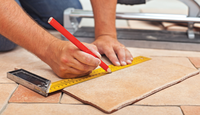Laying Tiles
Although sometimes awkward to use, tiling window managers are effective. X Tile can be used to expand a standard window manager with tiling functions, combining the best of both worlds.

Nagy-Bagoly Arpad, 123RF
Although sometimes awkward to use, tiling window managers are effective. X Tile can be used to expand a standard window manager with tiling functions, combining the best of both worlds.
Window managers are responsible for doing just what their name suggests: They administer windows on a desktop. Among many other tasks, this involves positioning windows on a virtual desktop
Window managers come mainly in two varieties. The majority only permit arbitrary positioning, or moving, of windows, which can easily lead to overlapping windows.
A tiling window manager works differently. It arranges windows so that, if possible, they do not sit on top of one another. The tiling manager does this by automatically adapting the size and the positioning, which results in better use of the desktop.
[...]